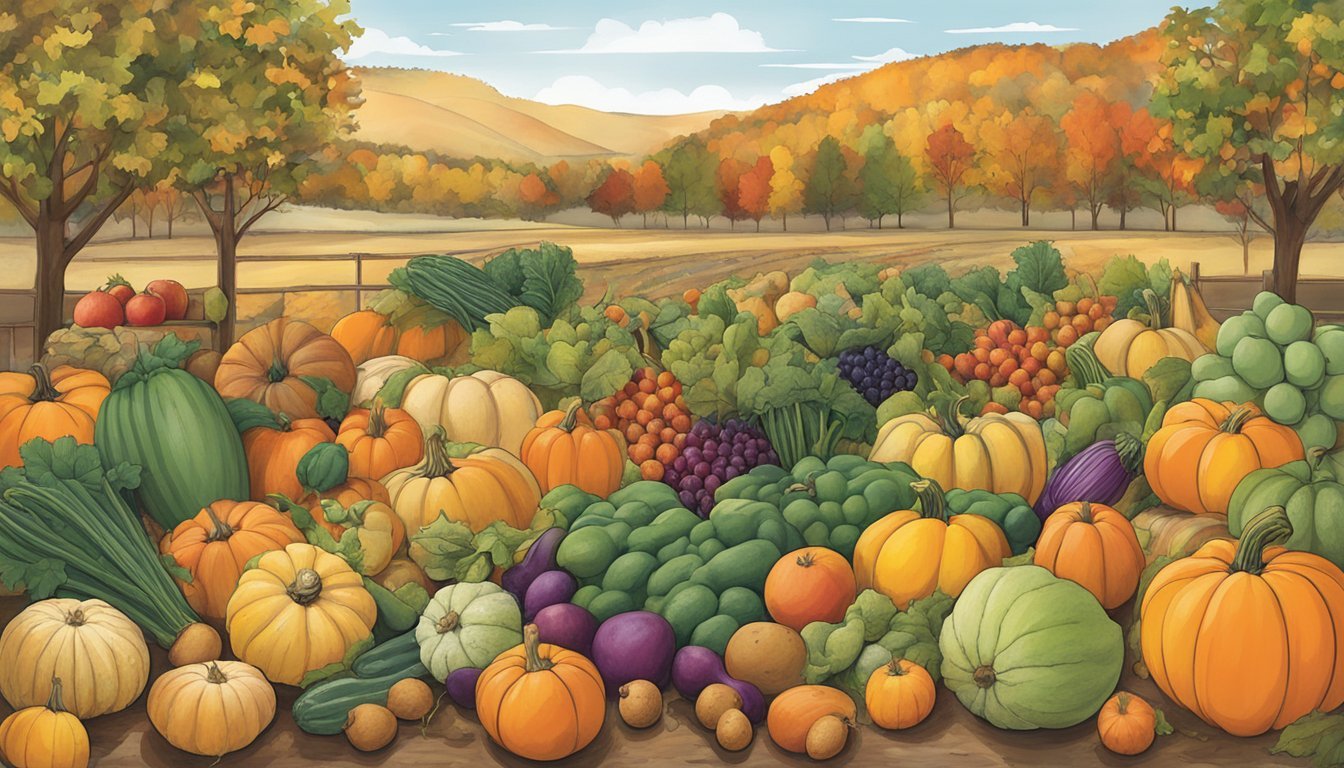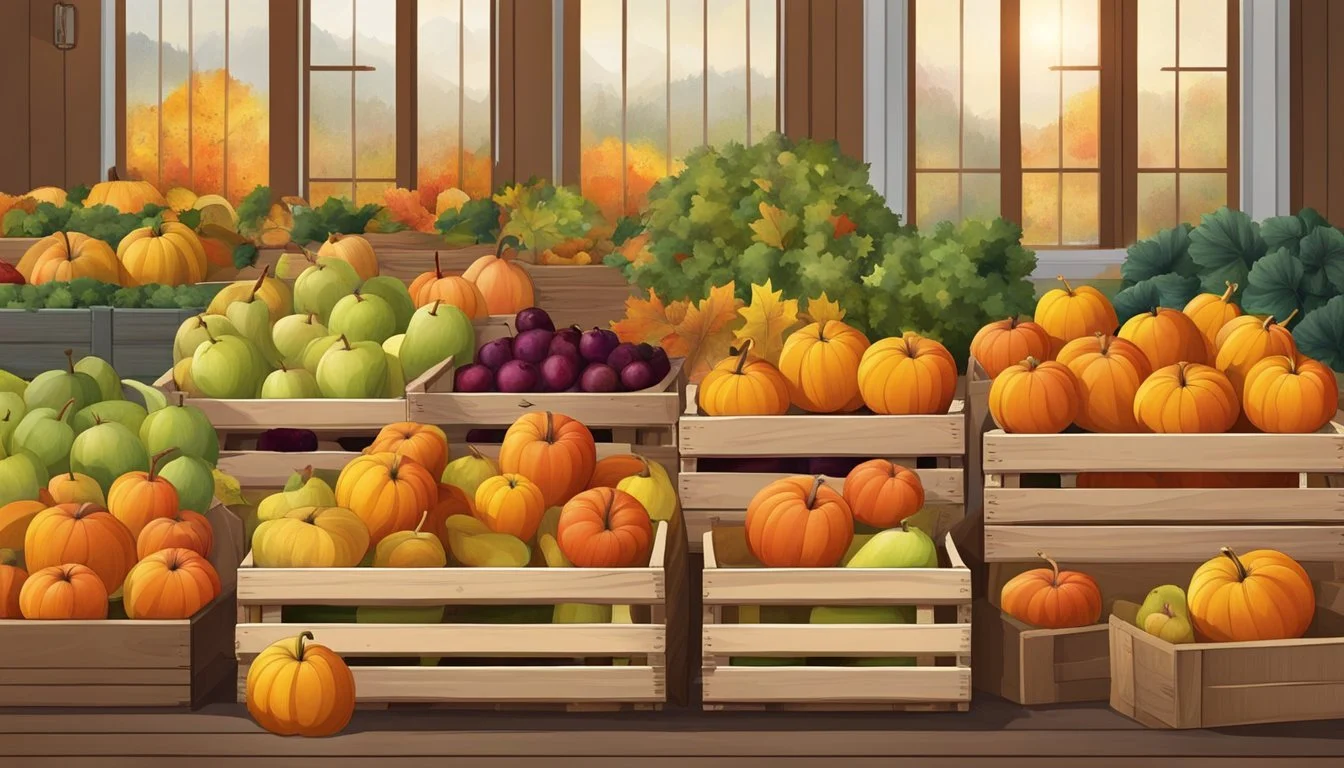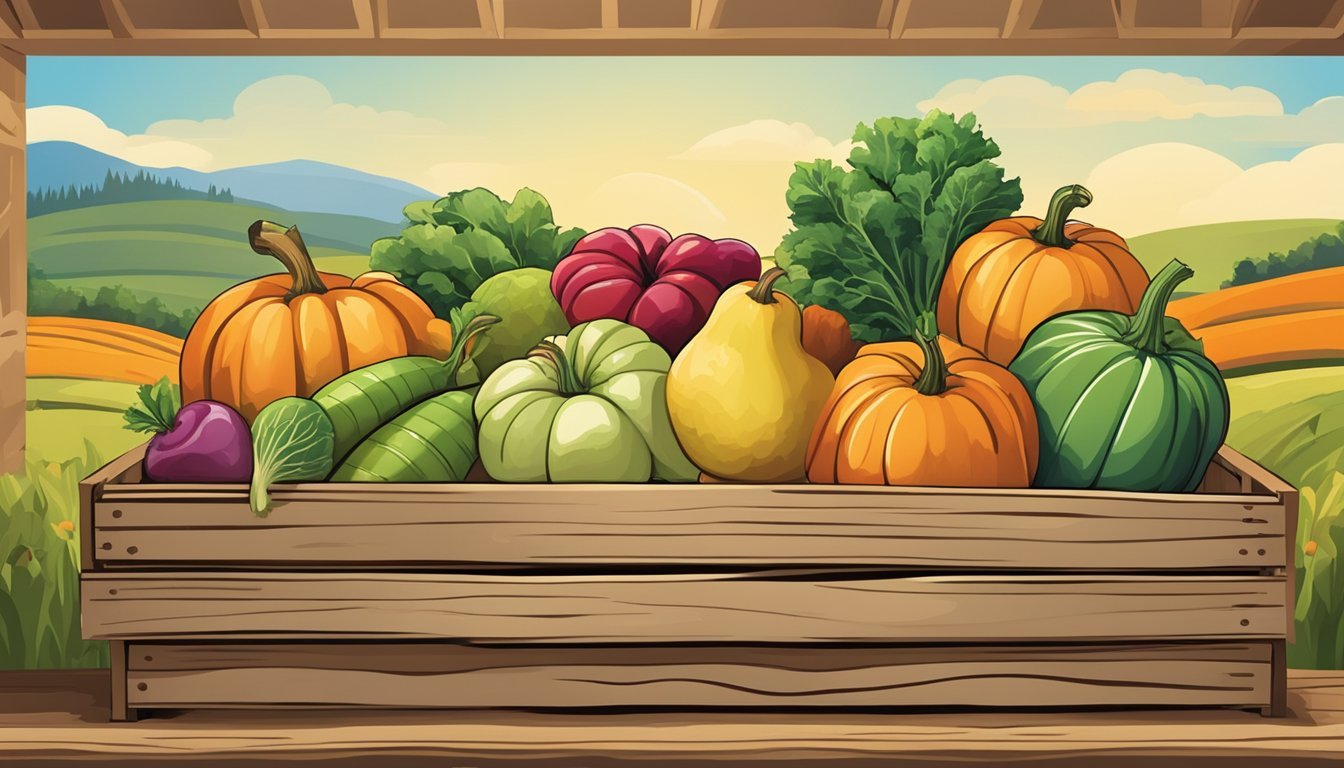Colorado Seasonal Fruit & Vegetables in November
Your Guide to Fresh Produce
This Article is Part of our Colorado Seasonal Fruit & Veg Calendar
As the brisk winds of November sweep through Colorado, the state's produce offerings shift to reflect the cooler temperatures and shorter days. Colorado's agricultural bounty continues into the late fall with a variety of fruits and vegetables that thrive in the chill of approaching winter. The seasonal harvest at this time of year includes root vegetables and hardy greens that can withstand frost as well as late-ripening fruits that add a burst of freshness to the Thanksgiving table.
Root vegetables such as potatoes, carrots, and beets (how long do beets last?) are abundant, their earthy flavors emblematic of November's hearty meals. These staples store well and offer robust nutritional value, making them ideal for warming soups and stews (What wine goes well with stews?). Among the greens, kale and collard greens stand out for their nutrient density and versatility in the kitchen. Their slightly bitter taste softens with cooking and pairs well with the richer flavors common in cold-weather recipes.
While many fruits have finished their season, apples continue to be a highlight in Colorado during November. Orchards offer a range of apple varieties perfect for both eating fresh and cooking into desserts or cider. The endurance of these fruits showcases the adaptability of Colorado's produce to its unique climate, offering locals and visitors alike a taste of the state's agricultural heritage.
Understanding Colorado's Climate and Seasons
Colorado's diverse climate plays a pivotal role in determining the seasonal availability of fruits and vegetables. Factors such as temperature swings and regional weather patterns are crucial for agricultural planning.
Seasonal Weather Patterns
Colorado experiences a wide range of weather patterns due to its varied topography, which includes mountains, foothills, high plains, and desert lands. The state's weather is characterized by:
Fall: Mild to cool days and crisp nights, with first frosts typically arriving by October.
Winter: Cold temperatures with considerable snowfall in the mountains, while the plains see lighter snow and occasionally milder days.
The state's geographical diversity can cause simultaneous contrasting weather conditions across regions.
Impact of Climate on Agriculture
The climate in Colorado distinctly impacts its agricultural output, particularly in the fall and winter months:
Fall: Harvest continues for hardy crops capable of withstanding the initial frosts.
Winter: Agriculture relies heavily on greenhouses to extend growing seasons or to produce certain crops year-round.
Temperature variances, especially during the transition from fall to winter, influence the types of crops that can be cultivated during these seasons.
November's Harvest Calendar
November in Colorado boasts a variety of produce as the season transitions from the colorful abundance of fall towards the first whispers of winter. Farmers and consumers alike can anticipate the last flourish of the harvest season.
Early November Produce
In early November, the remaining autumn crops are gathered before the first deep frosts. Colorado sees the tail end of the apple harvest, with late varieties such as Granny Smith and Fuji reaching peak ripeness. Here's a snapshot of what to expect:
Apples: Granny Smith, Fuji
Root Vegetables: Beets, Carrots
Greens: Kale, Spinach
Winter Squash: Butternut, Acorn
Mid to Late November Harvest
As November progresses, the focus shifts to hearty vegetables that store well through colder months. It is the prime time for harvesting root vegetables which have fully developed their flavors. Potatoes and onions are staples, coming in from the fields in abundance. Additionally, greenhouse cultivation allows for extended availability of some produce:
Root Vegetables: Potatoes, Onions, Turnips
Brassicas: Brussel Sprouts, Cabbage
Greenhouse Produce: Herbs, Lettuces
Greenhouse-grown herbs and lettuces provide fresh greens even as the outdoor temperatures drop. Consumers can enjoy these robust flavors, knowing they are enjoying the tail end of Colorado’s bountiful harvest season.
Key Seasonal Fruits in November
In November, Colorado's orchards yield a hearty selection of fruits suited to the cooling climate. Apples and pears hit their peak, while certain berries cling to the branches, offering a late-season harvest for those who seek them.
Apples and Pears Varieties
Apples in Colorado are abundant in November, with a variety to suit every taste. One finds the tangy Granny Smith, perfect for pies, alongside sweet selections like the Honeycrisp and Fuji. For apple connoisseurs, heirloom varieties such as the Winesap or Braeburn provide unique flavor profiles that are both rich and aromatic.
Pears are equally diverse, ranging from the buttery, soft texture of Bartletts to the firm, crispness of Boscs. D'Anjou pears, both red and green varieties, remain a favorite, their subtle sweetness intensifying as winter approaches.
Late Fall Berries
While many associate berries with summer months, some hardy varieties persist into the late fall. One may still find raspberries if the frosts have been light, though they are nearing the end of their season. It’s a brief window where these berries can be foraged or purchased from local markets, adding a burst of flavor to autumn dishes.
Essential Vegetables Available in November
In November, Colorado's fall harvest provides an array of nutritious vegetables from subterranean staples to vitamin-rich greens.
Root Vegetables and Tubers
Key components in the Colorado November harvest are root vegetables and tubers, robust in flavor and nutrition. Potatoes, versatile and hearty, are in steady supply. Gardeners unearth beets, offering earthy sweetness and vibrant color to dishes. Crunchy and sweet, carrots are also gathered, perfect for both raw and cooked preparations.
Potatoes: Abundant and diverse in variety.
Beets: Deep reds and golden hues, full of antioxidants.
Carrots: Available in orange, purple, and yellow, rich in beta-carotene.
Cruciferous and Leafy Greens
The cooler temperatures of November encourage the flourishing of cruciferous and leafy greens. Kale stands out, packed with vitamins and a slightly peppery taste. Spinach, tender and mild, is also plentiful, offering versatility in salads and cooked dishes. Don’t overlook onions, as they form the backbone for countless recipes with their essential flavors.
Kale: Dense with nutrients, can be eaten raw or cooked.
Spinach: Soft leaves, ideal for a variety of recipes.
Onions: Fundamental for savory flavor profiles, available in several varieties.
Seasonal Squash and Pumpkins
November in Colorado heralds a time when squash and pumpkins reach their peak maturity, offering a bountiful harvest. Often associated with autumnal feasts, winter squash and pumpkins are especially prominent during this month.
Winter squash boasts a variety of shapes and sizes, uniting different species under one seasonal banner. It includes butternut, acorn, and spaghetti squash, among others. They are known for their hard, thick skins, allowing for longer storage periods. This trait makes them a staple well into the winter months. Their flesh tends to be firm with a sweet, nutty flavor that intensifies with cooking.
Pumpkins, on the other hand, are not just for decoration; they are a versatile culinary ingredient. While some varieties are bred for carving, others are cultivated for their delicious flesh. They offer a deep orange, fiber-rich pulp that can be roasted, mashed, or pureed.
Here is a brief overview of these November favorites:
Butternut Squash: (how long does butternut squash last?) Smooth, tan skin with an orange fleshy pulp that turns increasingly sweet.
Acorn Squash: Recognizable by its ridged skin and acorn shape, it has a slightly sweet and nutty taste.
Spaghetti Squash: When cooked, its flesh falls away in ribbons or strands resembling spaghetti, offering a unique texture.
Pie Pumpkins: Smaller and sweeter than their carving counterparts, these pumpkins are ideal for baking.
Throughout Colorado, farmers markets and produce stands feature these local gourds, signaling the season's rich offerings. They can be prepared in a multitude of ways—roasted, baked, steamed, or sautéed—and occupy a central role in seasonal dishes.
Using Colorado Produce in Autumn Recipes
Colorado's November harvest offers a bounty of fresh produce perfect for creating heartwarming meals and sides. This plethora of available ingredients can enhance the flavors of traditional Thanksgiving dishes, add freshness to salads and sides, and enrich the depth of stews and soups.
Thanksgiving Staples
For Thanksgiving, chefs might leverage local produce like apples, carrots, and pumpkins. These ingredients can be transformed into classic dishes that celebrate the flavors of the region.
Apples: One can bake them into pies or make homemade apple sauce as a side.
Pumpkins: Perfect for making traditional pumpkin pie or as a savory addition to casseroles.
Carrots: Can be glazed with a touch of local honey for a sweet side dish.
Warm Salads and Sides
Salads and sides don't have to be cold to be refreshing. Utilize ingredients like beets and chard to create warm dishes that complement any main course.
Beets: Roast them for a warm beet salad with goat cheese, or incorporate them into barley salads.
Chard: Sauté it with garlic and a splash of balsamic vinegar for a flavorful side.
Hearty Stews and Soups
Hearty stews and soups are ideal for Colorado's November chill. With ingredients like kale, onions, and various squashes, these meals become both nutritious and comforting.
Squash: Butternut or acorn squash work wonderfully in creamy soups or vegetable stews.
Onions: A base for any soup or stew, they add essential flavor.
Kale: Adds a nutritional punch and texture to soups, like a classic kale and white bean stew.
Where to Find Seasonal Produce
In November, Colorado's seasonal produce can still be found if one knows where to look. The state prides itself on offering a variety of fresh fruit and vegetables from local sources.
Local Farmers Markets
Farmers markets in Colorado are a treasure trove for seasonal produce. They operate in various towns and cities and are known for providing a wide array of freshly harvested fruits and vegetables. In November, shoppers may find late-season offerings such as winter squash and root vegetables. Key locations include:
Boulder Farmers Market: A vibrant market known for its quality and variety.
Denver Union Station Farmers Market: Offers a selection of produce from local Colorado farms.
To find a farmers market near you in Colorado, one can visit the Colorado Department of Agriculture's website for a comprehensive list and schedule.
Community Supported Agriculture (CSA)
CSAs are a popular way for consumers to buy local, seasonal food directly from a farmer. Memberships or subscriptions are purchased from a farmer in advance of the growing season, and in return, members receive a portion of the farm's harvest. This can include a variety of fresh fruits and hearty winter vegetables. Some notable Colorado CSAs include:
Grant Farms CSA: Located in the Northern part of the state, it provides a range of produce and often includes unique heirloom varieties.
Cure Organic Farm CSA: Situated in Boulder, known for organic produce and a commitment to sustainable farming practices.
These channels support Colorado's agricultural community and ensure that consumers have access to fresh, seasonal produce, even as the days grow shorter and the weather cools.
Benefits of Eating Seasonally and Locally
In November, Colorado residents can reap numerous benefits from choosing seasonal and local fruits and vegetables. These advantages include peak nutrition, reduced environmental impact, and bolstered local economies.
Nutritional Advantages
Eating produce during its proper harvest season ensures that individuals receive the highest possible nutrient content. For example, root vegetables like carrots and beets, which are harvested in Colorado in the fall, are dense in fiber and rich in vitamins. Leafy greens like kale and spinach also offer robust flavor and concentrated nutrients when picked in their prime.
Environmental Impact
Local and seasonal eating supports a healthier climate by reducing the carbon footprint associated with long-distance transportation. Purchasing local harvests translates to less fuel consumption and lower greenhouse gas emissions. As the climate cools in Colorado during the late autumn, the area’s harvests adjust, offering produce that thrives in chillier conditions, thus adhering to natural growth patterns without the need for forced cultivation.
Economic Benefits
Investing in the community’s agriculture by purchasing local produce bolsters the economy. Money spent on local farmers' markets and community-supported agriculture (CSA) programs stays within the community, supporting the livelihoods of local growers. Seasonal buying further promotes economic resilience by aligning consumer demand with the natural growing cycles of the region.
Preserving Colorado's Bountiful Harvest
To maximize the lifespan of Colorado's November harvest, proper preservation techniques are crucial, especially with the early frost. These methodologies safeguard the quality and nutritional value of produce for extended enjoyment.
Canning and Freezing Techniques
Canning is a reliable method to preserve fruits and vegetables harvested in November. Key steps include:
Sterilization: Ensure that all canning jars and lids are sterilized.
Filling: Pack the prepared produce into jars, leaving proper headspace.
Sealing: Apply the lids and process in a boiling water canner or pressure canner based on the type of produce.
For freezing, individuals should:
Blanch: Briefly boil vegetables to stop enzyme activity that causes spoilage.
Cool: Immediately cool them in ice water to halt the cooking process.
Dry: Pat produce dry to prevent freezer burn.
Package: Place them in airtight containers or freezer bags.
Fermentation and Pickling
Fermentation enhances flavor while preserving. Vegetables like cabbage can be turned into sauerkraut through natural fermentation processes. Steps include:
Preparation: Shred cabbage and add non-iodized salt (how long does iodized salt last?).
Fermentation: Tightly pack the mixture in a container, cover it with a cloth, and allow it to ferment at room temperature for several weeks.
In pickling, vinegar and salt brines are used. To pickle your harvest, one should:
Prepare the Brine: Typically a mixture of vinegar, water, and salt, sometimes with sugar and spices.
Submerge the Produce: Place the vegetables in the brine and ensure they are completely covered.
Seal and Store: After packing the produce in jars with brine, store them in a cool and dark place until they are pickled.









